Why do black spots appear on cauliflower and is it safe to eat?
Many gardeners strive to grow cauliflower on their own plot, but sometimes, hoping for a good harvest of beautiful heads of cabbage, they are disappointed when they notice black spots and dots on the inflorescences. How to prevent their occurrence and whether you can eat such cabbage, read on.
Black spots on cauliflower - what are they?
Cauliflower was obtained through breeding work. It does not exist in the wild.
It is not surprising that this crop is susceptible to various diseases and pests. It reacts to minor changes in the composition of the soil, does not tolerate excessive moisture and violation of the rules of care.
Reasons for appearance
On cauliflower leaves (usually on the outer ones), black dots appear due to excess nitrogen or lack of mineral fertilizers: potassium, phosphorus, boron, molybdenum.
Cabbage is also affected by diseases and insect pests, which leave behind traces in the form of dots.
Diseases
The main cause of black spots on cabbage leaves is punctate necrosis. But other diseases can also cause an outwardly similar manifestation.
It is important for a gardener to know their main signs in order to take the necessary measures in a timely manner.
Point necrosis
This is a physiological disease that is not transmitted from head to head. However, the damage from the disease is very noticeable.
The inner and outer sides of the sheet are covered with black or dark lead dots and spots of round or indeterminate shape.At first there are few of them, but over time they become more numerous. The size of the spots is from 3 mm, they look slightly depressed.
Over time, the affected areas increase in size and the leaves die off. The most common cause of plant damage is excess nitrogen fertilizers. Further development of the disease is facilitated by improper storage conditions.
Alternaria or black spot
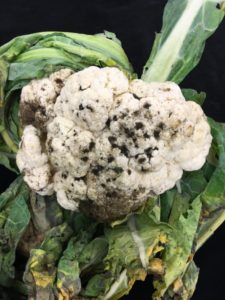
This fungal disease is usually caused by excess moisture. The infection affects both young plants (seedlings) and adult, already formed heads of cabbage.
Small black dots and spots with a sooty coating (fungal spores) appear. They infect the base of the cabbage head, first individual inflorescences, and then the rest.
Brown rot begins to develop. The flowers turn brown, making the cabbage unfit for consumption.
Mosaic
A viral disease transmitted by various species of aphids. It can be detected already a month after planting the seedlings: black and dark brown spots form on the leaves between the veins, spreading from the base of the leaf.
Subsequently, they grow, merging and forming extensive areas of necrosis. Leaves curl and die.
The infection cannot be treated, so infected plants and weeds from between rows must be immediately eliminated.
Gray rot
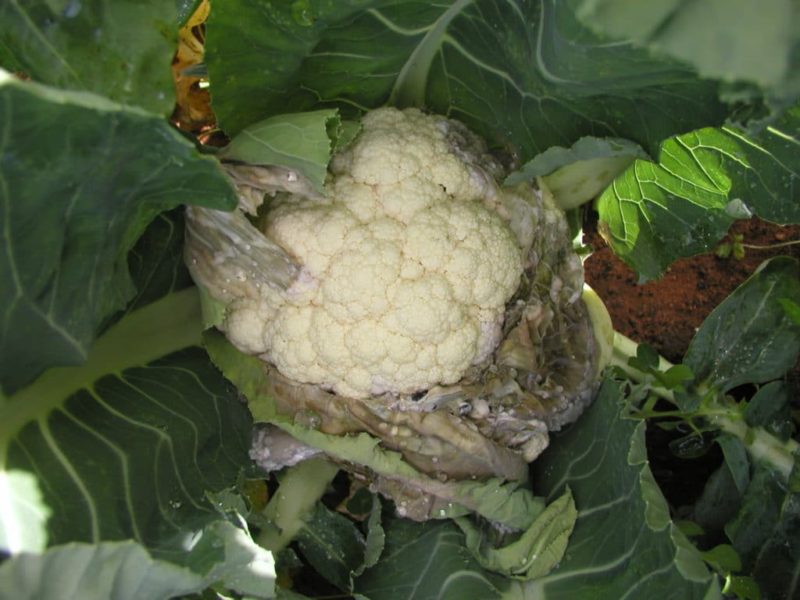
It appears as dark gray spots covered with a cotton-like coating on the head of cauliflower. These areas begin to rot. The disease usually affects frozen or injured cabbage.
Long periods of damp, cool weather also contribute to this. The rot is cut off with a knife to prevent infection of the entire head of cabbage.
Mucous bacteriosis, or wet bacterial rot
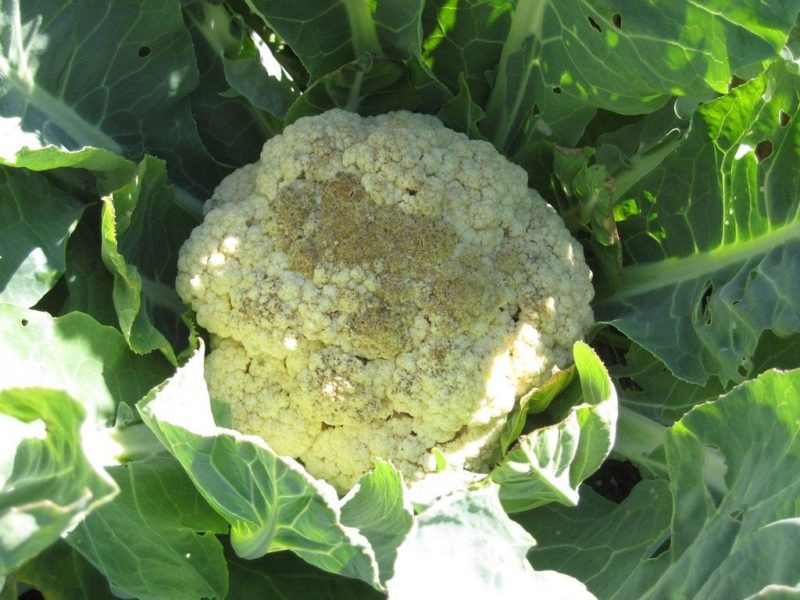
This is one of the most common diseases of cauliflower. Affects any type of crop in all phases of growth. First, oily spots appear on the inflorescences. Then they turn black and begin to rot. The disease leads to underdevelopment of plants and even their death.
Pests
Harmful insects also leave black spots and spots on cauliflower.
In addition, you can find other traces of their activity: holes of various sizes, passages, sticky honeydew, excrement.
Thrips
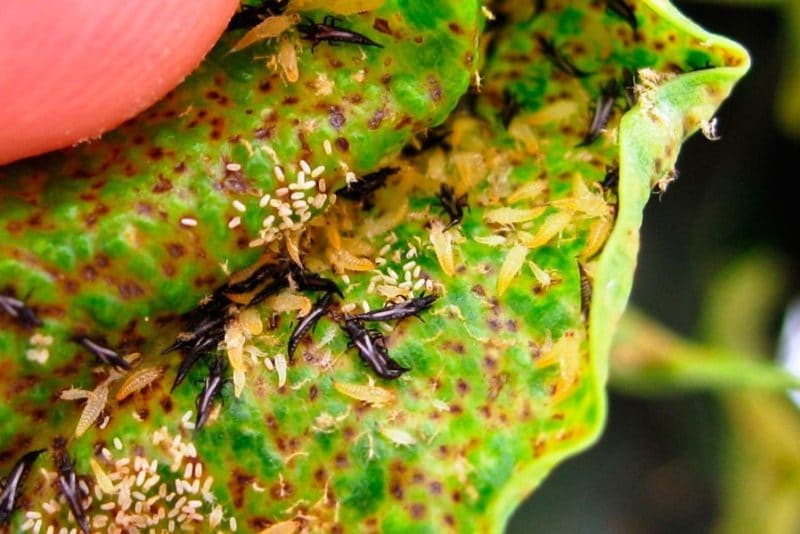
During the growing season, it is difficult to distinguish them in the beds. These are small insects measuring 2 mm. Unlike aphids, they do not form dense colonies, but the damage from them is still significant: cabbage heads lose their marketable appearance, and with a large infestation they become unusable.
Thrips feed on cabbage leaves and inflorescences, leaving behind rusty spots that then turn black.
Cabbage flea beetle
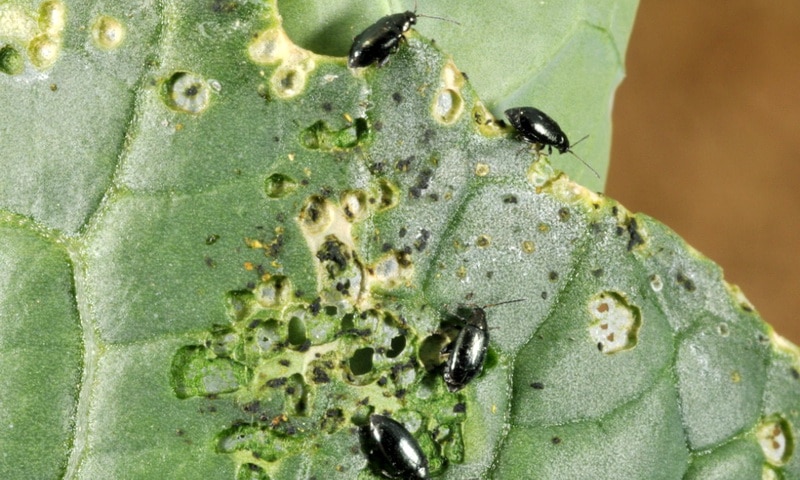
If small black dots and holes appear on the cabbage leaf plate, it means that the beds are being attacked by cruciferous flea beetles. As a result, the riddled cabbage foliage dies.
A microscopic jumping bug can quickly destroy all planting material. It is most often found on young plants.
Cabbage fly
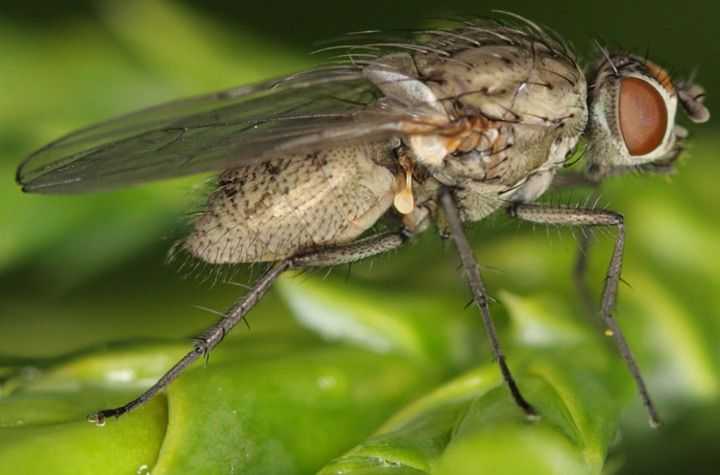
Externally, the insect is similar to a housefly, but slightly smaller in size. The fly lays eggs in the soil around the plant and on its stem.
The larvae, penetrating the stem, eat away the winding passages in it, after which the cabbage landings they look as if they do not have enough water: they droop and wither. As the larvae grow, they destroy not only the cauliflower itself, but also the surrounding crops.
Cabbage butterfly
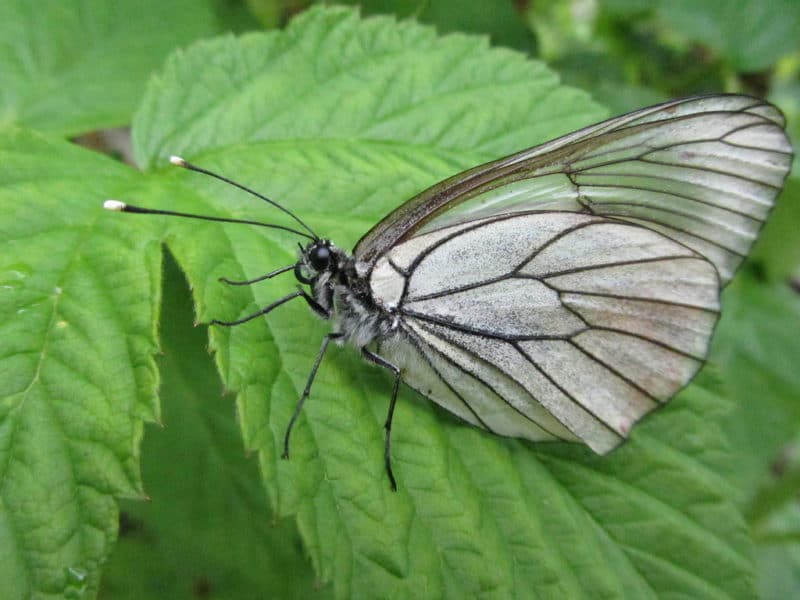
Cabbage white larvae cause great damage to cauliflower plantings.The caterpillars eat holes of various sizes in the leaves and leave excrement in the form of black dots. Sometimes all that remains of a large leaf is a skeleton of veins.
Unfavorable environmental conditions
Cauliflower - cold-resistant culture but it does not tolerate high temperatures, especially when there is a lack of moisture in the soil.
The plant becomes frail and does not develop, which leads to all sorts of diseases: mucous and vascular bacteriosis, mosaic, etc.
Errors in care
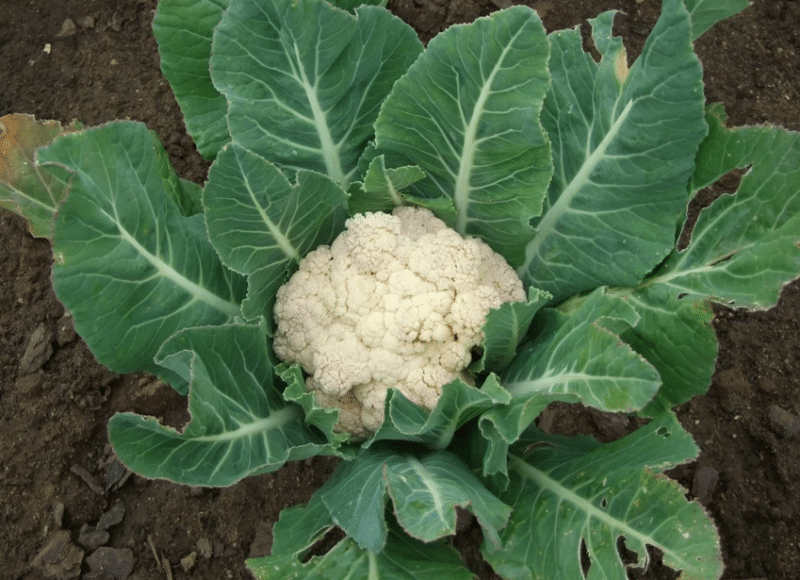
Sometimes gardeners themselves make mistakes. when growing crops, Because of this, it weakens and is susceptible to various diseases and pest attacks. As a result, leaves and inflorescences become covered with black dots, spots, necrotic areas, and acquire an unnatural color.
The most common mistakes:
- Incorrect watering. Cabbage consists of 90-94% water, so it must constantly receive moisture. However, frequent and abundant watering leads to excessive soil moisture, which also retards the growth and development of the crop. A weakened plant is susceptible to fungal and bacterial infections and attacks by insect pests.
- Cabbage is planted in the shade. The absence of light weakens culture and stops its development. This condition contributes to the development of diseases.
- Crop rotation is not observed. If cabbage is planted in the same bed more often than 4 years later, there is a high risk of infection with diseases such as clubroot or bacteriosis.
- Soil that is too acidic or alkaline. In such soil, cauliflower grows and develops poorly.
- Deficiency of micro- and macroelements or excess feeding.
At different stages of the growing season, the plant requires fertilizer complexes of different compositions.
Fighting methods
Various methods of combating diseases and pests of the crop help to save cauliflower:
- There are currently no reliable measures to combat punctate necrosis, since the causes of this disease are unclear. Agronomists recommend reducing nitrogen application rates in the second half of summer (it does not harm seedlings) and selecting disease-resistant plants. varieties: Amager 611, Slava 1305, Belorusskaya 455, Zimovka 1474, etc.
- In the fight against Alternaria blight, spraying plants with Skor and Quadris has shown high efficiency. From folk remedies - a solution: 30 g of laundry soap and soda ash are dissolved in 10 liters of water. After spraying, the product creates a protective film on the leaves and shoots.
- Mosaic is viral in nature and cannot be treated with insecticides. In this case, preventive measures are important: destruction of diseased plants, disinfection of seeds, timely cleaning of beds from weeds, control of pests that carry the virus.
- It is necessary to urgently get rid of heads of cabbage affected by gray rot. But it is better not to allow this, but to observe crop rotation, do not apply nitrogen fertilizers at the end of the growing season, use only high-quality planting material, reduce watering 3 weeks before harvesting, and avoid damaging the heads of cabbage.
- To prevent mucous bacteriosis, planting holes are watered with the biological preparation “Binoram”, plants are dusted with wood ash, weeds are promptly removed, and seeds are treated. The development of mucous bacteriosis (wet bacterial rot) often begins when water stagnates in the soil. Therefore, it is important to follow the correct watering schedule and avoid overmoistening the soil.
When controlling pests, insecticides are usually used to treat plants and soil.The drug “Bankol” is a universal insecticide with a wide spectrum of action.
Summer residents often use folk remedies:
- A concentrated solution of laundry soap is effective against aphids: 100 g of soap per 10 liters of water.
- To repel caterpillars and slugs, dry mustard, lime, and ash are sprinkled between the rows.
- For cabbage flea beetles, flies and butterflies, infusions and decoctions of onion peels, garlic, hot pepper, as well as solutions with ash and soap are used.
- A good protection against pests will be herbs (fennel, marigolds, dill, parsley, calendula), planted near the garden bed, or better yet, along its perimeter.
Can you eat cauliflower if it has black spots?
If blackheads are noticeable in small numbers and are located only on the outer layer of the head, they should be carefully cut off, separate the inflorescences and soak for 15-20 minutes in a saline solution to better cleanse the product.
Then the inflorescences are washed with clean water and eaten. In case of severe damage, it is better to dispose of the head of cabbage.
Black spots
Black spots usually appear due to Alternaria, which is dangerous in the form of fungal spores. Such a head of cabbage cannot be completely cleaned, so it is better to throw it away.
Dark brown, gray dots
Such symptoms in cabbage are caused by gray rot and mucous bacteriosis. The inflorescences are affected by brown spots, which give off an unpleasant odor. In this case, the vegetable is unsuitable for consumption.
How to prevent the problem
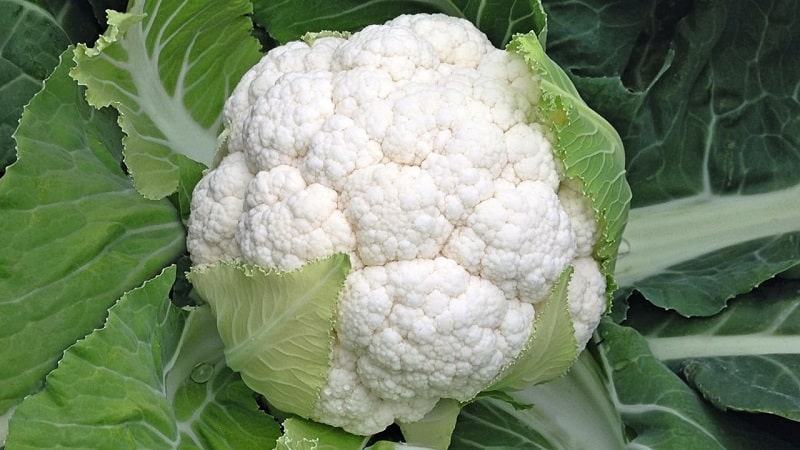
To protect cauliflower from diseases and pestsTo preserve the harvest, it is necessary to properly organize the care of the crop and not forget about preventive measures:
- observe crop rotation;
- in the fall, carry out deep digging of the soil;
- choose varieties that are resistant to diseases and pests;
- treat the seed material using the drug “Thiram”;
- plant seedlings on time and do not thicken the planting;
- regulate the acidity of the soil and the application of fertilizers (phosphorus-potassium, as well as those containing boron and molybdenum);
- get rid of weeds in a timely manner;
- regularly water and mulch the soil;
- carry out disease and pest prevention;
- harvest only in dry weather;
- send heads of cabbage for storage without mechanical damage or visible signs of disease;
- create optimal conditions for storing vegetables: good room ventilation, air temperature from 0 to +1°C, humidity 85-90%.
Conclusion
Cauliflower is a very delicate crop that is susceptible to a large number of diseases. However, the fight against them comes down only to strict adherence to the rules of agricultural technology and preventive measures.
By strictly following them, you will be able to avoid the appearance of black spots and various spots on the cabbage and get healthy heads of cabbage at the end of the season.